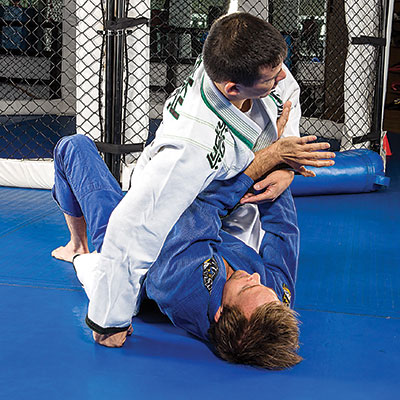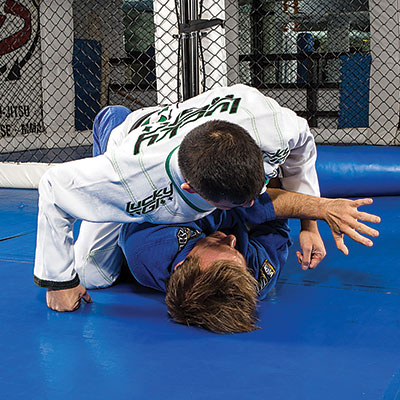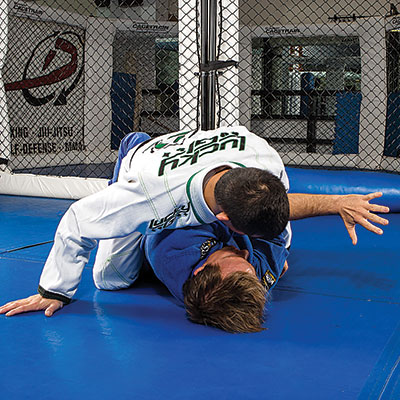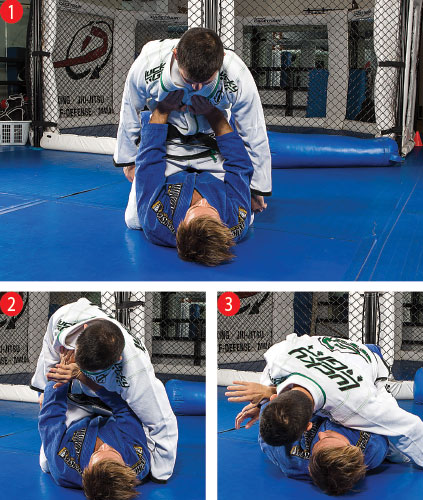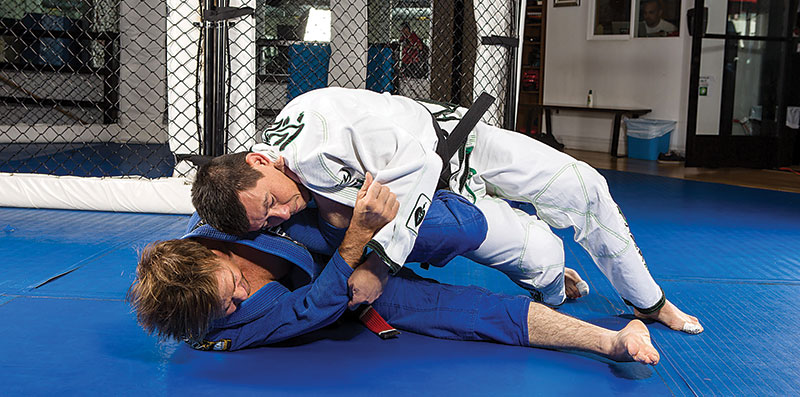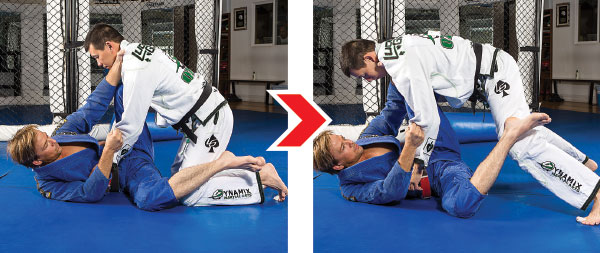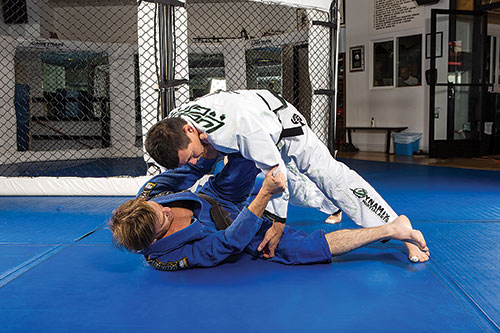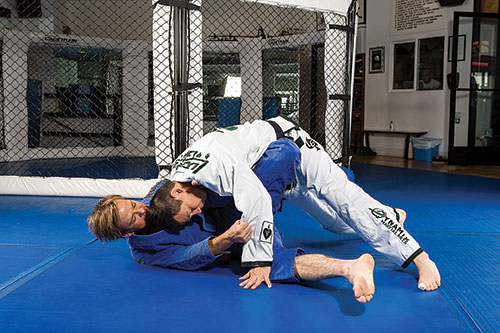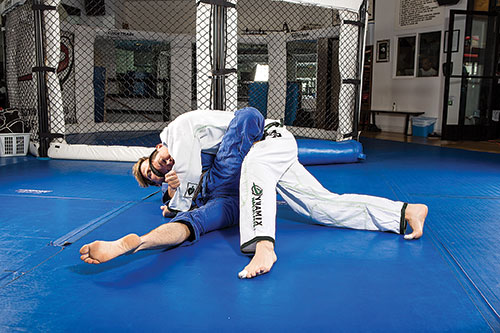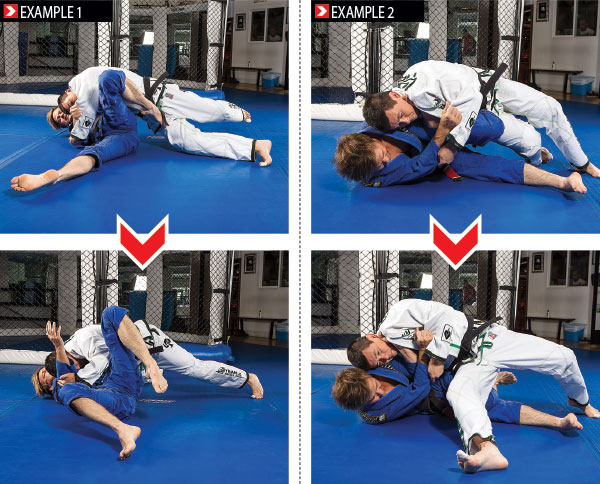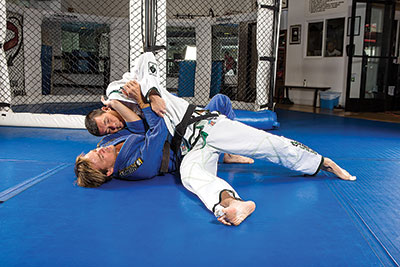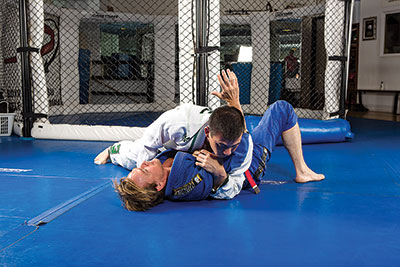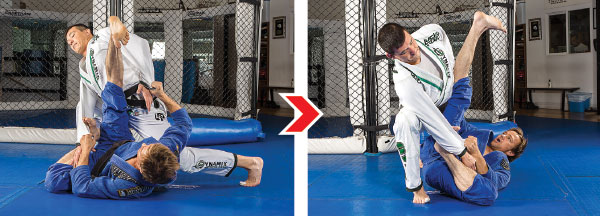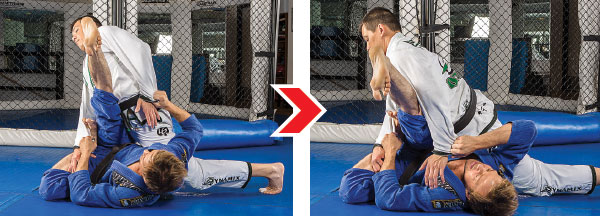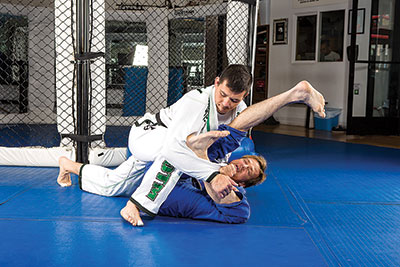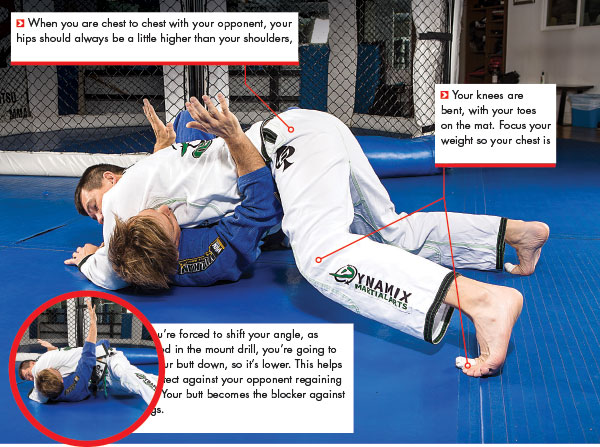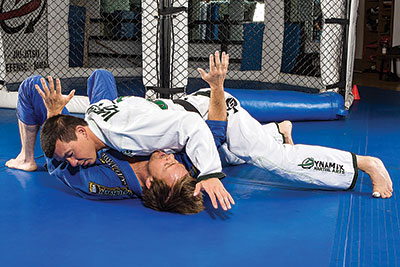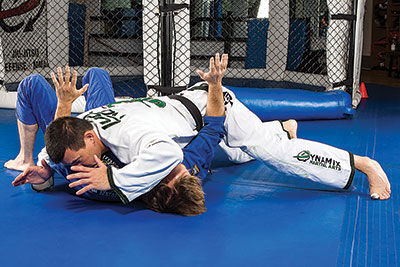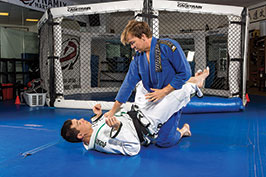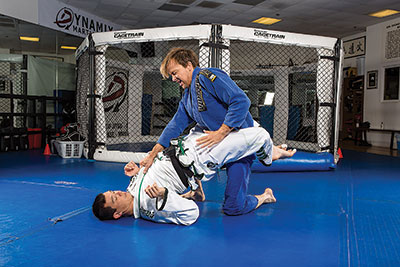"Invisible Jiu-Jitsu" Weight Distribution with Henry Akins
The concept of invisible jiu-jitsu was taught to Henry over the years by Rickson Gracie. What Rickson coined as the term “Invisible Jiu-Jitsu” is actually based on two concepts, weight distribution being one and being in connection with your opponent the other, larger part. In interviews Rickson talks a lot about this “connection,” which allows you to feel what your opponent is going to do almost before he does it. This knowledge allows all of your movements to be far more effective. In this article Henry is going to focus on the weight distribution concept of Invisible Jiu-Jitsu. The concept was first illustrated to Henry years ago. Henry was a blue belt student at the Rickson Gracie Academy when one of the world’s best competitive jiu-jitsu athletes came through the school. He was a two-time world champion and fresh off a Pan-Am win. The world champion was much bigger, stronger, and younger than Rickson. About five minutes into sparring, Rickson forced the champion to tap without even using a submission. Rickson used invisible jiu-jitsu to inflict so much pain, discomfort, and exhaustion onto his opponent, the champion had no choice but to tap. At that point, Henry was so in awe of the concept that it became a pillar of his own jiu-jitsu. Rickson’s jiu-jitsu is regarded as the most direct and true definition of jiu-jitsu as Grand Master Helio intended it.
In this article Henry shares with us the concept of weight distribution, understanding it, drilling with it, and employing it in some common situations. The information he’s about to impart with us might seem like a lot to grasp, but it’s just the basic concept. Many articles can be written on the concept, and as anything in jiu-jitsu, the only way to really grasp and understand it is to do it, over and over again. No matter your belt rank or your years of experience, I’ve personally never come across a subject that I’ve felt so strongly about. I would suggest that everyone who practices jiu-jitsu play with this concept, give it some attention and try it in your own jiu-jitsu. It may not work for you; actually I can’t imagine it not working for you, but do yourself a huge favor and try it.
Henry began training jiu-jitsu in 1995 and moved out from Oklahoma, abandoning a promising education in genetic engineering for the purpose of learning jiu-jitsu under Rickson Gracie, widely regarded as the greatest living example of jiu-jitsu in the world. Nine years later, Henry became Rickson’s third American to be awarded a black belt. Henry went on to become the head instructor at the Rickson Gracie Academy. Today, Henry is partnered with former UFC fighter Antoni Hardonk, as owners of Dynamix Martial Arts in Santa Monica, California.
www.dynamixmartialarts.com
For more techniques from Henry Click HERE
Shifting Your Angles
Shifting angles is the easiest way to explain how to use your weight to kill the other guy’s leverage, and can be mastered in a day if you dedicate yourself to it. Mastering this step first is the best way to get comfortable with this concept. Here’s a step-by-step on how to train this position.
1. Starting mounted on your partner, have him push off against your chest and rest your weight on top of him. Be relaxed. The person on bottom will quickly begin to feel a large portion of your body weight.
2. Now, start to shift your angle, drop one shoulder down towards your opponent, don’t just move, really focus your weight on that downed shoulder.
3. As you shift your angle you’re forcing your partner to lose the leverage on that side. More than likely you’ll collapse down to his elbow being that’s the only thing keeping you off of him entirely.
4. Now, change the angle again, with your other shoulder down, this forces his elbow outward and he’s forced to let you collapse down to his chest.
Key Points
This is the same concept of weight distribution that you’re going to use when passing the guard. Instead of your opponent using his arms to keep you away, he’ll be using his legs. The weight distribution concept is the same.
For more techniques from Henry Click HERE
From the Mount Position
Easy Drill: Start in the mounted position and have your partner on bottom push off at different angles for one minute then switch. The partner on top’s goal is to shift his angle away from the point of contact to eventually get his chest to his partner’s chest.
Perform the above drill for five rounds with each of you taking turns on the bottom. Take a break, and then do it again, and again. If you have more than one partner to perform this drill with, change it up and maybe do a round robin. Getting a feel for how to shift your weight to kill the angle is probably the biggest key to mastering this concept. Drilling with partners of different weights and sizes will only help you grasp and properly employ the concept.
Weight Distribution
The weight distribution concept that Henry’s showing us can be used any time you’re on a top position. This is where it has the most benefit; however, it can also be used when you’re on the bottom in certain circumstances. Henry’s going to give us a glimpse of that as well. There are a lot of benefits to being able to properly use your weight. One of the most useful benefits is the toll it takes on your opponent’s breathing and heart rate, especially from side control. Using your weight properly makes it more difficult for your opponent to breathe. In a long match, that can have a huge effect. In the short term it can take him off his mental game. He may look to force an escape that isn’t there if he’s at all claustrophobic or really uncomfortable. The second dramatic benefit is forcing your partner to deal with your weight. Any time he wants to move, or to move you, he’s going to have to deal with much more of your static mass than he would if you were in a more traditional position with your weight. The side-control example we’ll get into later dramatically shows this concept. When you properly apply your weight on top of your partner, it’s like a CrossFit workout for him. Imagine him having to rep 160-180lbs non-stop for the length of time you’re on top. It doesn’t take very long to break him down both mentally and physically.
Proper weight distribution allows the person on top to relax, not fight so much, and really open up his mind to focus on the opportunities the person on bottom presents. These opportunities will come because the person on the bottom constantly has to deal with a huge amount of resistance any time he wants to move or do anything.
Guard Passing
Weight distribution is crucial when it comes to passing the guard. The whole idea of passing the guard is to move forward, and to soak up the space between you and your opponent. You’re trying to get past the person’s legs, trying to get your chest to his chest. Any movement backward is counter productive to your goal. When the person on the bottom is playing open guard, the idea for him is to create distance, to keep you away. He’s using his legs to keep you at bay, he’s trying to control your arms so he can sweep you or keep you off balance. He’s trying to constantly keep distance from you so you cannot pass. Any time he puts anything on you, a foot, a leg, an arm, a knee, you’re going to do the same thing you did in the mount drill. You’re going to engage your weight and shift angles to basically kill whatever he’s putting in front of you. Henry tries not to use his arms when passing. He feels that it’s inefficient, the guy on the bottom is using his legs, which are so much stronger than the arms. This is not a fair fight and will tire out the person on top if he’s relying too much on his arms.
For more techniques from Henry Click HERE
Guard Passing Drills
For these drills try not to use your hands, just try to use your body weight and shift the angels. The hands will eventually help out, but at this point, when Henry passes, he doesn’t find the need to use his arms very often.
Open Guard With Leg Shield
This is a drill for a typical open guard with the person on the bottom using his leg as a shield; he has control of a sleeve, and control of the collar. This is a solid position for the person on the bottom. He has options to sweep, options to choke, and could rest in that position if he was so inclined.
1. The first thing for the person on top to recognize is that if your knees are on the ground, then your weight is not on your opponent. Any time you’re passing the guard you want to be on your toes with your weight on your opponent.
2. Notice immediately that the person on the bottom is no longer relaxed. He has to deal with 100+ pounds that just got placed on top of him. He’s forced to engage his muscles.
3. Henry’s biggest obstacle in obtaining his goal of getting his chest to his opponent’s in side control is Sean’s left leg. So, to kill the leg, Henry turns his angle, dropping his right hip and upper body down, focusing his weight on that side.
4. Once Henry has turned his angle he’s collapsed, his head and chest are already closer to Sean, and now Sean only has his left hook keeping Henry from the pass.
5. From there, Henry only has to walk his feet to his right to pass, or he can stretch out his right leg and step to the front.
Key Points
If Henry steps his right leg over and goes to the front, all he needs to then do is get on his toes and drive forward to move into side control.
If Henry walks to his right and goes to his back he stays on his toes, controls Sean’s far arm to keep him from rolling and flattens him out for side control.
Sean tries to spin in the direction he’s going, to Henry’s right. To stop the spin, all he has to do is grab onto Sean’s pants near his right side hip to prevent the spin and eventually complete the pass.
For more techniques from Henry Click HERE
Spider Guard
Spider guard has become a mainstay guard these days and can be frustrating if you’re not prepared to deal with it. The most common passes usually involve the person attempting to pass by breaking a grip using mostly his arms and then throwing the legs like a Toriano pass, the entire time maintaining the distance that the person using the spider guard is looking for. Henry’s spider guard pass quickly eliminates the distance, and once again, forces his opponent to deal with his weight from the beginning.
1. Sean has his foot on the crook of Henry’s right elbow, with control of that same sleeve. Henry steps off to his left side, Sean’s right, and forces his weight onto Sean’s leg.
2. Henry’s weight is applied, not as just a “thrust,” but is being “applied” across and down onto Sean’s leg. This kills his control of the arm and puts Henry’s weight on top of Sean.
3. Henry keeps his weight on top of Sean, he’s practically in a side control position.
4. If Sean keeps control of Henry’s left arm with his foot, then Henry rotates his elbow over or can use his knee to free it.
Key Points
Notice that during this pass Henry’s knees never contact the mat. If he were to drop to his knees after killing the control of his left arm, Sean would be able to recover by bringing his right knee up as a shield. If his knees hit the mat, then Sean wouldn’t be forced to deal with Henry’s weight.
For more techniques from Henry Click HERE
Side Control
Now that you’ve passed the guard, you’ve gotten into the side control position. Henry says this is the position in which this concept can have the greatest effect. Henry has seen many black belts tap simply from the pressure being placed on them from this concept being utilized correctly. No submission; it’s just so uncomfortable, they can’t breathe and they end up tapping.
Rules of Side Control
Whenever you’re in side control with your opponent you are NEVER on your knees, and you’re never sitting on your butt. Whenever you do either of these things that means your weight is no longer engaging your opponent. Your weight is being wasted, so keep the knees up, and stay on your toes.
Keeping The Position
1. If your opponent wants to turn into you, bring your hips up and force the pressure down and forward to flatten him out.
2. If he tries to push your hip away, just drop the other hip. So, here Sean is pushing against Henry’s left hip. Henry drops his right hip and eliminates the angle and leverage. If Henry didn’t do this and tried to resist instead, he might leave himself open to getting swept.
3. Although not a rule, Henry likes to keep his right arm near his opponent’s hip as a simple way of protecting against the guard recovery, his left arm is over his opponent’s shoulder, but he’s careful not to rest it on the mat. This would reduce the amount of weight being placed on his opponent.
4. When it’s time to attack the far arm, Henry will bring both arms over and maintain the chest-to-chest weight the entire time. Bringing the right arm over does pose a problem in protecting against the guard recovery.
5. When your have both of your arms to your opponent’s side you must be cautious of his guard recovery. He could sneak a knee in there to begin to recover. Any time you feel him start to bring his leg up you have two options. You can either bring your left leg underneath your body, pivoting to your right. Or, you can do a “sit out” to your left bringing your right leg across, near your opponent’s head. With either example, remember to keep your butt and knees off the mat and remain on your toes so he’s dealing with your weight.
[row][double_paragraph] [/double_paragraph][double_paragraph]
[/double_paragraph][double_paragraph]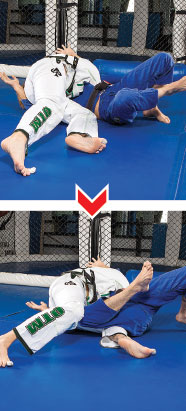 [/double_paragraph] [/row]
[/double_paragraph] [/row]
6. Once you get a good grasp of the concept of using your hips to block that guard recovery you’ll find that attacking the far arm with your weight concentrated on your opponent is really easy. You’ll feel very light and fluid. From a more conventional side control you’re not nearly as mobile as you are when you’re on your toes. It’s easier to adjust because you’re very light with your weight on your opponent.
Key Points
When your opponent is trying to escape the cross side position he usually tries to get to his side so he can either recover guard or get back to his belly then his knees. Always try to adjust your weight and put it towards whatever shoulder your opponent is trying to lift up. So the basic idea of side control is to use your weight to kill the shoulder your opponent is trying to lift off the mat to keep him flat on his back.
For more techniques from Henry Click HERE
Using your weight From The Bottom
In future issues we plan on exploring this concept more in depth with Henry. What he’s shown us in this article is really the tip of the iceberg. One thing you probably wouldn’t realize is that this concept is also applicable from the bottom. How is that possible, you ask? Well, the concept is about using your weight efficiently. Whether you’re holding 100 lbs. over your head, or carrying it at your sides, it’s still 100 lbs. working against you. From the bottom there are many ways to distribute your weight on your opponent to make their actions much more difficult. One way is preventing your opponent from standing up when in your closed guard. In this example Henry is going to shift his weight and focus it on his opponent at just the right time. When done correctly it feels more like a parlor trick than jiu-jitsu, but it’s extremely effective and can be used to set up a sweep, or bring your opponent into your clinch.
1. Sean is in Henry’s closed guard. Sean steps up with his right leg first. This means that in order for Sean to stand up, at some point, he’s going to have to place all of his own weight on his right leg so he can get his left leg up. [/third_paragraph][third_paragraph]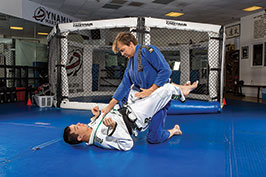
2. Henry “bites” his legs into Sean’s hips. [/third_paragraph][third_paragraph]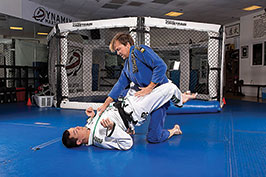
3. Next, Henry raises his hips and rather than being relaxed, is placing the weight of his lower body onto Sean. [/third_paragraph][/row]
4. As soon as Sean begins to put his weight on his right foot to stand up Henry can feel the movement and focuses his weight onto Sean’s left knee. This transfer makes it extremely difficult for Sean to stand up on that left leg. [/double_paragraph][double_paragraph]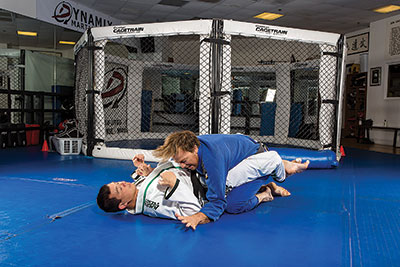
5. With Sean stuck and off balance, Henry can then pull Sean into him, bringing him into the clinch. The real desired effect is to keep your opponent from standing and working his guard pass. [/double_paragraph] [/row]
Conclusion
If you’re a regular reader of JJM, you’ve seen a lot of technique articles. Hopefully, many of those have helped you improve your jiu-jitsu. In the three years that we’ve been around and I’ve been writing these articles, I can honestly say that this one, this concept of invisible jiu-jitsu, has had by far the most profound impact on my own jiu-jitsu. I’ve employed countless techniques I’ve written about, but this is not one simple technique. This is a concept, that when employed properly, will “transform” you and your jiu-jitsu forever. I’ve been using this concept for about two months now after Henry first demonstrated it to me in person. Since then I feel like it’s had an immeasurable impact on my jiu-jitsu. I’ve managed to submit fellow purple belts without a submission. Almost every partner I’ve sparred with has told me how heavy I felt, and how stifling my top game is now. Guys who used to pull guard on me now fight for top position from the start. That’s helped my confidence, and in turn, improved every aspect of my jiu-jitsu. And that comes only after a couple of months. I’m still just a novice with the concept at best. I really hope that you’ll give it a chance and dedicate some time to embrace it. I think you’ll be very thankful you did, and all your opponents will rue the day.
For more techniques from Henry Click HERE



